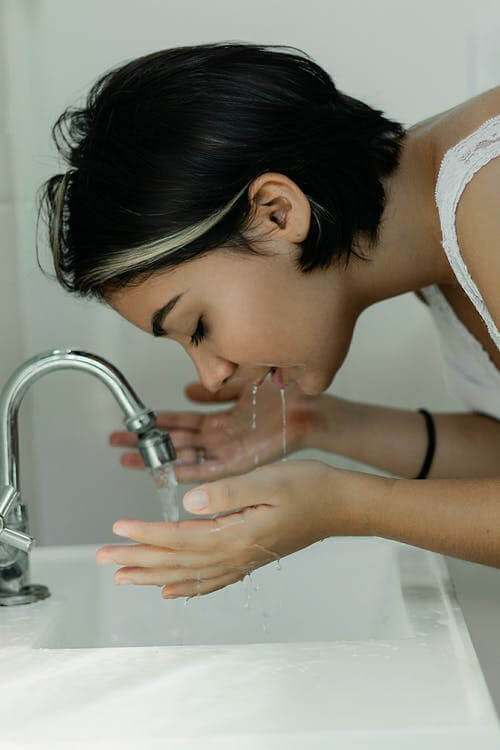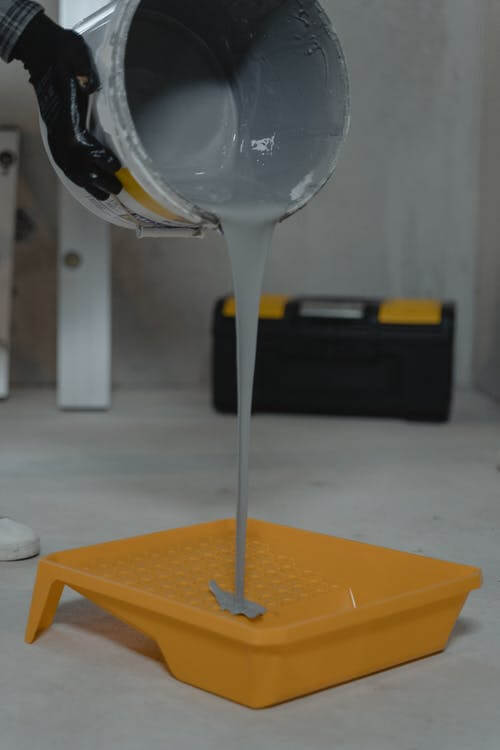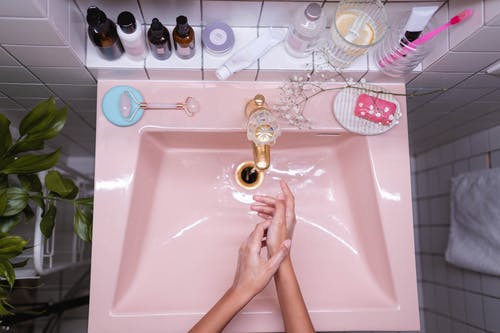Paint a sink? It may seem like an oddly specific question, but it’s one that people always ask.
Yes, you can paint a sink. Your kitchen or bathroom sink could use some sprucing up; paint is just what you need.
Painting your sinks is inexpensive and will also help them last longer.
So, here’s how to paint a sink.
What to Consider

Painting your kitchen or bathroom sinks can be an easy way to make them look new and fresh again, not to mention that they adds value to your home. If you are thinking about painting the sink in your kitchen, there are many factors that go into this decision.
For example: do you have enough time on your hands? Do you want it done quickly, or is quality more important than speed? Is the labor cost worth the investment for such a small work area?
And finally, what color best suits all other aspects of our decorating scheme at home?
The choices are limitless, it’s all about finding the perfect color for your space.
The paint that you use is also important to consider. Do you want a matte or glossy finish? What type of paint will allow us to clean our sink with less elbow grease and even resist water spots better than others?
There are so many different options when it comes to paint, it’s important that you know what your needs are before making a purchase.
But the best part is painting a sink is one of those DIY projects where anyone can succeed with just very little effort and knowledge about how to paint.
This blog post will walk through all the steps from start to finish on how someone can do this themselves.
How Much Would Paint Cost For My Kitchen Sink?

The cost of paint for a bathroom sink can vary depending on several factors, such as the type of paint you choose, the sink size, and the paint’s brand. Here are some key points to consider:
- Type of Paint: For bathroom sinks, you would typically use a specialized paint designed for high moisture areas and surfaces frequently touching or exposed to water. Epoxy paint is a common choice for this purpose.
- Size of the Sink: The amount of paint needed will depend on the size of your sink. A smaller sink will require less paint, whereas a larger or double sink might require more.
- Quality and Brand: Higher-quality paints are usually more expensive but may offer better coverage, durability, and finish. The brand can also affect the price.
- Additional Supplies: Remember to account for additional supplies, such as primer, brushes, or rollers.
As a rough estimate, you might spend anywhere from $20 to $60 for quality epoxy paint for a standard-sized bathroom sink, but this can vary widely based on the factors mentioned. It’s best to check with your local hardware store or an online retailer for specific prices based on your needs.
If you are looking at doing several projects around the house then it might be worth buying some paint from a bulk store so you can get all of your supplies together and save money.
Working on several tasks at once is great because it helps us save time. This means we can take fewer days off from work, avoid going out for things like painting, and have more time for fun with family and friends. It also allows us to stay home when we’re sick and spend more quality time with loved ones.
Get Ready for Your Painting Adventure
Before you start applying paint to your sink, it’s essential to gather everything you need. This is a list of items that you should have on hand:
- Fine-textured sandpaper (220-grit)
- A cleaning solution like TSP (Trisodium Phosphate) to remove grease
- Plastic sheeting to protect your surroundings
- Painters tape to mark off the areas that shouldn’t be painted
- A primer paint to help the color coat adhere better
- Paint in the color of your choice (pick a shade that is durable and water-resistant)
- Brushes to apply the paint
Step 1: Clean It Up
Before you begin painting, you need to clean your sink to get rid of dirt, grease, or oils that could prevent the paint from sticking. First, use a degreaser, such as TSP, and scrub your sink with a brush. Then, rinse it thoroughly and let it dry completely.
Step 2: Sand It Smooth
The next step is to sand your sink to make it smooth and help the primer and paint adhere better. Gently sand the sink with sandpaper, making sure to even out any rough spots. After sanding, wipe the sink down with a clean cloth to remove any sanding dust.
Step 3: Protect Your Space
To prevent accidental painting, use plastic sheeting to cover the countertops, floor, or anything nearby. Secure it in place with painter’s tape.
Step 4: Get Primed
Before painting, it’s crucial to prime the sink. Apply an even layer of primer to the sink, covering every inch. Then, let it dry completely, following the instructions on the primer can. This step is important because it helps the paint stick and provides a base for the color coat.
Step 5: Time to Paint
Once the primer is dry, it’s finally time to paint! Start by painting the edges and corners, then fill in the rest of the sink. Use a high-quality paintbrush to achieve a smooth and even finish. If you need a second coat, wait for the drying time specified on the paint can.
Step 6: Add a Protective Layer
After waiting a day or two for the paint to dry, it’s time to add a final touch. Use a brush or roller to apply a thin layer of lacquer to the sink, starting from one corner. Wait 5 hours for it to dry, then add another layer if you want extra protection.
Don’t wait too long between layers; moisture could damage your sink over time.
Step 7: Clean Up
Now that the paint is dry remove the plastic sheeting and painter’s tape. Clean your brushes with water and store them properly. If needed, reattach any fixtures or hardware to the sink.
Painting your sink is a fantastic way to give your bathroom or kitchen a new and improved look, and it’s super easy and budget-friendly. By following these steps, you’ll have a sink that looks like it was professionally painted, and it’ll last for years to come.
You might be interested: How To Hang Drywall Like a Pro
Tips & Tricks on How to Paint a Sink

- The paint can be applied with a brush, roller, or sprayer.
- When using a brush, make sure to use one made of synthetic bristles that won’t soak up the paint and cause it to drip back down onto your furniture or walls.
- Spray painting will often require more coats than other methods because paint sprayers don’t evenly distribute the paint without dripping in certain areas.
- Rolling is typically less expensive and uses much less material per coat than brushing does – but this may take longer for larger sinks with many corners along the edges.
- The brushes are better left dry when you’re not working on them as they can be stored in an upright position so gravity helps pull any excess moisture out from within their bristles.
- If you are using a brush make sure to use it in long, even strokes and avoid painting over any dried paint within the area that we’re working on for this project which can cause streaks or uneven-looking surfaces.
- When applying the paint to your sink you want to keep in mind how thick of a layer you are painting so as not to pile on too much and cause drips. If it is layered thin then there will be less dripping which means less clean-up time afterward. This also saves money because we don’t have to buy more paint if some has spilled onto the ground or onto another surface area by mistake – such as our clothes when reaching around back into the cabinet under where we used our sinks. Oopsies happen sometimes.
- When applying your first coat of paint try not to go back over areas too many times because this will only end up smearing what was just painted and lead us into some more clean-up time afterward. It is better if there are fewer layers of paint so that when it drips down onto another surface like our clothes from reaching around back into the cabinet under where we used our sinks then there won’t be as much mess.
- Paint in thin, even strokes. This will avoid creating brush marks that can be seen through the paint and make it look like dirt or scratches. Brushstrokes should go with the grain of the wood so as not to create too many lines – this is a very common mistake. To save time when covering large areas we recommend using an angled roller instead of a traditional paintbrush which takes more effort and has less coverage area for each stroke. Use rollers whenever possible because they are fast-drying, great for smoothing out surface imperfections (like bumps or dents), and help provide a seamless finish by reducing brush marks and drips.
- The paint will dry within a day or two, but you’ll want to wait to put the sink back into use until 24 hours have passed. This allows time for all of the fumes from the paint and drying process (which can be pretty strong) to dissipate so they don’t get on your clothes when using them afterward.
- You might also want an extra set of hands around while painting – depending on how large your sink is this could help with getting in hard-to-reach places like under pipes, faucets, and corners. Plus if there’s one thing we know about family members – they’re always more than happy to pitch in.
- You should also make sure to protect the surrounding surfaces with a drop cloth or other covering. This will prevent paint from getting all over floors, cupboards, and walls in the event that it spills as you’re painting.
So now that you have been exposed to our top tips, go paint your sink!
If you have any questions feel free to leave them below.


















